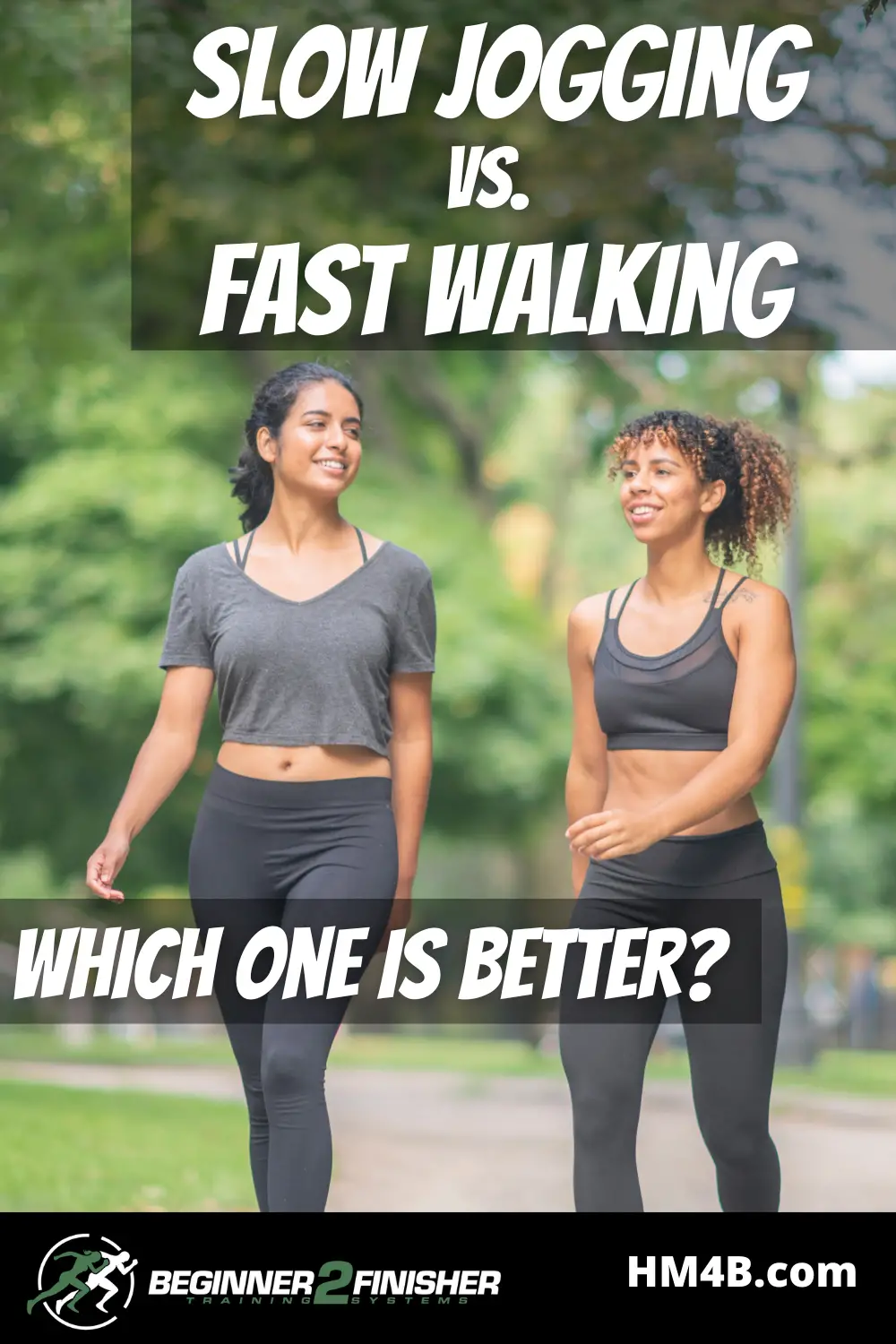Ready to conquer your fitness goals but don’t know whether to start fast walking or slow jogging?
Speed walking and jogging slowly are aerobic exercises with similar health benefits, such as weight loss and a decreased likelihood of heart disease. However, the latter places far more pressure on your joints, tendons, bones, and ligaments than power walking. Not to mention it’s more effective for fat loss thanks to the increased calorie burn.
In this article, we’ll explore the key differences between both activities and the pros and cons of each to help you choose your perfect exercise.
Slow Jogging VS. Fast Walking — The Key Differences
Fast walking and slow jogging are kinds of aerobic cardio exercises. Both offer similar health benefits, including a decreased risk of heart disease and weight loss. Not to mention the pace is the same.
Despite the similarities, these activities were not created equally. Believe it or not, there are significant differences between slow jogging and fast walking, as you’ll see below:
- Contact with the ground — The biggest difference is your feet’ contact with the ground. When walking, both feet are never off the ground simultaneously. When jogging, both feet are in the air simultaneously at points throughout the gait cycle, even if only for a millisecond.
- Energy expenditure — It takes more effort to slow jog than it does to fast walk. Thus, your body expends more energy when doing the former, as proved in a study conducted in 2019 and published in the Journal of Kinesiology and Exercise Sciences.
- Impact on the body — Your tendons, bones, and muscles experience higher pressure and stress when jogging than walking. Even at a slow pace, running can put pressure on your joints equal to roughly 2.5 times your body weight, as verified by a study in the Clinical Journal of Sports Medicine. Compare that to walking, which generates a force of 1.2 times your body weight, and the impact difference is massive.
- Calories burned — At this point, it probably comes as no shock that you burn more calories when slow jogging than power walking. Since it’s a more vigorous workout than walking (even though the pace is the same), you expend more energy and burn more calories.
Provided your joints are healthy, you’ll get a better sweat on when jogging slowly.
And yes, you might feel a touch silly running at the same pace as your power walking buddies, but you’re burning more calories, so who’s the real winner here?
The Benefits and Drawbacks of Slow Jogging and Fast Walking
Everything in life has ups and downs — slow jogging and fast walking are no different.
Although partaking in slow jogging feels like a no-brainer from the calorie side of things, its impact on your body isn’t right for everybody.
Slow Jogging Pros
If your goal is to lose weight, slow jogging is more effective than power walking because it burns more calories while maintaining a steady pace. Not to mention it boosts your immune system, effectively adds years to your life, and strengthens your heart.
On top of that, it improves your posture, general fitness, and physical appearance. Plus, slow jogging can increase your circulatory and respiratory systems’ efficiency and accelerate your metabolism.
Related: How can Long Slow Running Improve my overall running capacity?
In addition, it decreases the risk of civilization diseases like obesity, diabetes, and atherosclerosis, strengthening your muscles and tendons as it goes.
Like any aerobic activity, it’s also a fantastic stress reliever.
The Pros in a Nutshell
- An effective way to lose weight thanks to increased calorie burning
- Boosts immune system
- Strengthens heart, muscles, and tendons
- Improves efficacy of respiratory and circulatory systems
- Accelerates metabolism
- Decreases risk of diabetes, atherosclerosis, and obesity
- Enhances posture, appearance, and general fitness
- Relieves stress
Slow Jogging Cons
Despite the health-boosting advantages of slow jogging, it has some drawbacks that shouldn’t go unnoticed.
The biggest disadvantage is the extra strain it puts on your body, increasing the risk of injury to your joints, bones, tendons, ligaments, muscles, and kidneys.
Related: Are you new to running? Before you start running – you must read this!
The Cons in a Nutshell
- Puts increased pressure on the body
- Heightens the risk of injury
Fast Walking Pros
Speed walking enhances cardiovascular health and strengthens your muscles and bones like jogging. It can even increase your range of motion and shift the pressure from your joints to your muscles (where it should be!).
Power walking helps prevent heart disease, type 2 diabetes, and dementia. Plus, it can improve sleep quality, reducing the likelihood of developing sleep disorders. Some studies show fast walking can boost brain function too.
Even your resting heart rate, blood glucose, and cholesterol levels will improve after incorporating speed walking into your life.
A meta-analysis on all-cause mortality published in March 2022 by the National Institutes of Health proved walking faster can improve your life span.
Related: Is Walking Better For The Body Than Running?
The Pros in a Nutshell
- Enhances cardiovascular health
- Strengthens muscles and bones
- Increases range of motion
- Prevents heart disease, dementia, and type 2 diabetes
- Improves sleep quality
- Boosts cerebral function
- Betters blood glucose, resting heart rate, and cholesterol levels
- Lengthens life span
Fast Walking Cons
Due to the decreased vigor and impact of power walking on the body, you won’t burn as many calories as jogging, meaning it’s a less effective weight loss tool. Since it won’t elevate your heart rate as high as spritelier activities, your results will be limited.
Low-impact weight-bearing exercises like speed walking aren’t as good at building stronger bones as slow jogging, according to research conducted by the Bone Health and Osteoporosis Foundation.
Keep in mind that fast walking is a low-risk, not no-risk activity. Strutting along concrete or asphalt for long distances may cause shin splints.
The Cons in a Nutshell
- Burns fewer calories
- Less effective for weight loss and building strong bones
- Doesn’t elevate heart rate as much
- It May cause shin splints
Does Slow Jogging or Fast Walking Burn More Calories?
You already know that slow jogging burns more calories due to the ground reaction force and gait cycle. But let’s look at the math so you can really see the difference.
According to Harvard Health Publishing, a person weighing 155 pounds should expect to burn around 298 calories after brisk walking at 3.5 mph for 60 minutes.
With that in mind, half an hour of walking every day would burn a mere 1,043 a week, helping you lose one-third of a pound. And since a one- to two-pound loss per week is a satisfying rate for weight loss, you’d have to triple your power walking time to reach your goal.
The same person could expect to burn around 443 calories when slow jogging in the same conditions (i.e., a pace of 3.5 mph for 60 minutes)!
Of course, people weighing more than 155 pounds will burn even more calories. And if you slow jog faster than 3.5 miles per hour, you’ll also up the ante.
We suggest using a calories burned calculator to estimate how much you would burn when slow jogging over specific distances.
Related: Check out this ultimate guide to losing weight by simply Walking
Is Slow Jogging or Fast Walking Better When Trying to Build Muscle?
If an athletic-looking and performing body are what you’re after, jogging and speed walking are beneficial. But the activities don’t build muscle, even though they work your quads and calves.
Instead, aerobic exercises improve your cardiovascular fitness and help you lose fat when combined with a balanced diet. As you lose more fat, you’ll begin to look musclier as there won’t be additional layers of “fluff” covering the muscles you currently have.
In short, slow jogging and fast walking can give you the desirable lean look.
Which Activity Is Right for You?
Slow jogging is always a great choice if you’re in good enough shape to cope with the higher impact. After all, it burns more calories, is more effective at building stronger bones, and promotes heart health.
Slow jogging is the perfect middle ground for cardiovascular exercise — halfway between all-out running and walking.
If you are just starting your fitness journey and are currently overweight, jogging slowly may put too much pressure on your joints. So, speed walking is better in this scenario.
The low-impact activity is also perfect for people with a history of joint or ligament issues. Not to mention you can do it while out running errands (that’s right, no excuses!).
Whichever one you choose, follow Nike’s motto and just do it. Your heart, bones, respiratory system, brain, and body will thank you for it.
Related: Anarerboic vs. Aerobic – What Are The Key Differences?
Final Thoughts
While both activities present similar cardiovascular advantages, slow jogging places more force on your joints while burning more calories. It’s effective for weight loss, but the cons outweigh the pros for those with joint or tendon pain history.
Power walking is a fantastic starting point. You’ll benefit from some weight loss while kickstarting your fitness journey. But we recommend switching to slow jogging when you’re ready to see significant improvements.
| Help support me and subscribe to my YouTube channel. YouTube video - 30 ways to make your runs less painful! Coach Scott's Credentials:
|
To sign up for a FREE half marathon training schedule, log sheet, and pace predictor CLICK HERE.

Recommended gear for runners
Connect with me:
| facebook.com/BeginnerToFinisher/ |
References
https://sportcoaching.co.nz/slow-jogging-vs-fast-walking-benefits/#Slow_Jogging_vs_Fast_walking_8211_What_is_the_Difference
https://uk.sports.yahoo.com/news/slow-jogging-vs-fast-walking-080000534.html
https://www.mz-store.com/blog/slow-jogging-slow-running-running-workout-for-beginners/
https://www.livestrong.com/article/228672-disadvantages-of-walking-as-an-exercise/
https://livehealthy.chron.com/benefits-jogging-vs-walking-muscle-5438.html
https://www.verywellfit.com/benefits-of-speed-walking-3436249

